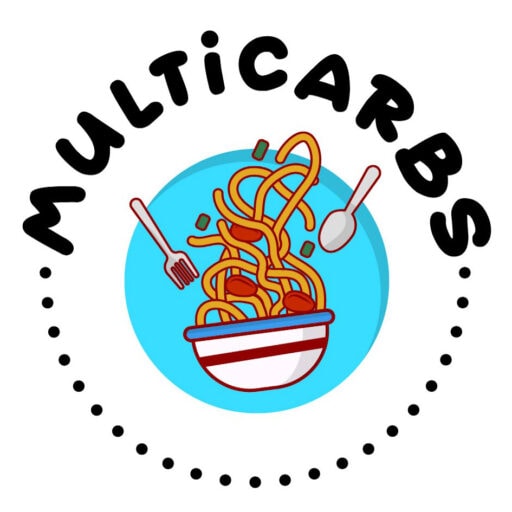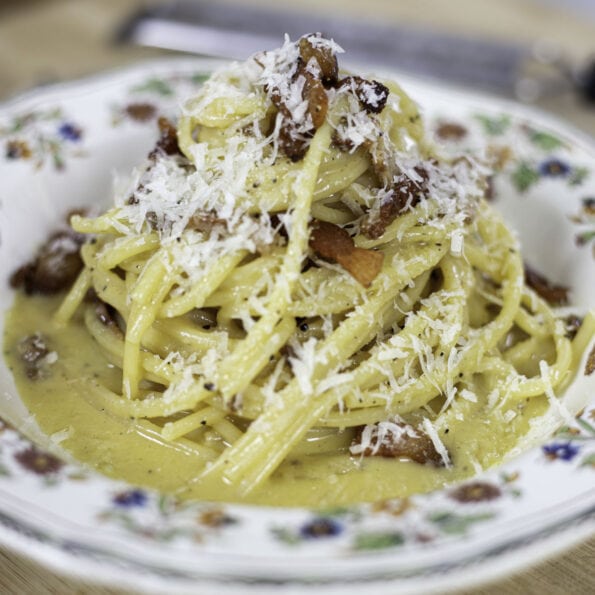
Authentic Carbonara

Authentic Carbonara Recipe
The authentic carbonara consists in pasta with guanciale - which is cured pork cheek, a highly fatty part- that you drench in a sauce made of eggs and pecorino (plus some parmigiano if you want to). The challenge is to reach the perfect texture for your sauce. You must not cook it, otherwise it will just be a pasta omelette ; but it must not be raw eggs either. If you follow my instructions, you should manage just fine !Ingredients - Advice & key points
I usually go to Eataly to get the produce I need. If you don't have one near your location, you can find fresh produce like guanciale and pecorino at your local Italian deli, maybe even your pasta. For pasta, if not available there, you should be able to order it online quite easily.- Pasta : While I believe tonnarelli is the best choice for this recipe, and was usually used in restaurants in Rome when I visited, spaghetti is also ideal.
- Guanciale : You can buy it in blocks at your deli or have it pre-sliced. We want quite thin slices -not paper-thin, but almost- so that they crisp up in the pan, about 1,5cm x 4cm.
- Cheese(s) : You can stick to Pecorino Romano only if you want to, which is the most traditional way, but I prefer a 50/50 blend or 70/30 blend with Parmigiano, which tones down the strong Pecorino flavour. It depends on your Pecorino type ; if it is quite aged, in the 24-36 months range, you might benefit from adding a bit of Parmigiano.
- Eggs : You should use the freshest eggs you can find, because the sauce is cooked, but barely.
- Pepper : It is important to use freshly ground black pepper. I personnally use this blend from Roellinger, but you can really use any, except highly fragrant, exotic ones.
Recipe - What to pay attention to
- Pasta :
- Don't oversalt ! While 10g of salt/liter is usually recommended, here, with the salt from the guanciale and the cheese, you can easily halve this amount.
- We'll cook the pasta half of the packet cooking time in water, then in the pan with the guanciale. It is important that you taste several times starting 2 minutes before the theoretical end time, so that you get perfect al dente pasta.
- Guanciale :
- You want to crisp it up, but still let the fat melt. Therefore, cook on medium heat. The process should last around 6 to 7 minutes.
- Pecorino :
- It is very important to thinly grate your Pecorino to that it melts properly. Look at my carbonara picture ; this is the thickest you can get. You can use a microplane, but if you have a kitchen robot with a really thin setting, it will also work just fine and save you the trouble.
- Do not use pre-grated cheese ! Additives are added to these cheeses so that they don't clump together, which will prevent it from integrating properly in your sauce.
- Adding your sauce : Remove your pan from heat at least 20 seconds before adding your sauce, otherwise the eggs might overcook. Then incorporate your sauce progressively.
- Plating : I highly recommend heating your plates in the oven for 10 minutes at 80°C before plating. This will prevent the sauce from getting cold too quickly and become unappealingly "set".
Carbonara is said to have been invented for charcoal burners (carbonari in Romanesco), who needed a hearty, filling dish to work long hours of this demanding job.
It is not healthy nor delicate. It is a bold, cheesy, comforting dish. For me, it is soul food at its finest.
- 180 grams Spaghetti
- 80 grams Guanciale (cut into thin strips)
- 3 eggs (1 whole, 2 yolks)
- 70 grams Pecorino romano (finely grated)
- 30 grams Parmigiano (finely grated)
- 5 grams black pepper (freshly ground)
- Do your grinding and dicing duty
Grind your pepper using a mortar and pestle (or the bottom of a small pan).
Grate your Pecorino Romano and your Parmigiano if using, with the thinnest grating tool you can find.
Cut your Guanciale into thin strips.
Please read above for any futher details on the ingredients and the way to prep them. - Get your eggs ready
To a bowl, add 2 egg yolks and 1 whole egg. Whisk it for 30 seconds. Add almost all the cheese, saving 3 tbsp to sprinkle at the end. Whisk.
To a pot, add a minimum of 2 liters of pasta water (at least 1 liter per 100 grams of pasta) and start heating.
Preheat oven to 80°C.
If making this dish for more than 2 people, add 1 egg yolk per person (don't add another whole egg) up to 4 people. - Cook your guanciale
To a cold pan, add your guanciale and 2/3 of your pepper. Start cooking on medium heat.
3 minutes in, add 10g of salt to your boiling pot of water. Add your pasta and let it cook.
Around 4 minutes later, once golden-brown, remove around 2/3 of the guanciale from the pan and put it on a plate covered with paper towel.
Put your serving plates into your preheaten oven.
Be careful not to burn the guanciale as it will turn bitter, but you want it golden-brown and crispy. When removing the guanciale, keep all the fat into the pan ! This is where all the flavour is. - Finish cooking your pasta in the pan
After half of your pasta cooking time (around 6 minutes with bronze-drawn pasta), add your pasta to the guanciale pan, using tongs.
Add 2 to 2,5 ladles of pasta water, and let it cook. Stir regularly.
Add half a ladle of pasta water to your egg mixture, stir.
- Add your egg mixture
Taste your pasta regularly.
When it is al dente, check your water level -there should still be around 1/2 ladle of pasta water in the pan ; if not, add some.
Remove from heat. Wait 20 to 40 seconds, then add your egg mixture progressively, either stirring with a wooden spoon or shaking directly your pan up (see video).
Adjust the amount of water if the sauce is not liquid enough. Heat it slightly on a very low fire if necessary.
I found that pan-cooking the pasta is slower ; it can take up to 5 minutes more than the assumed cooking time for the pasta to be fully cooked. Be careful though, it is important for it to be al dente. - Plate it up !
Take your plates out of the oven and serve your pasta immediately.
Pour the reserved crisped guanciale and cheese over your pasta. Sprinkle the remaining black pepper.
Et voilà ! You're done !!
- There are no good replacements for any ingredient of this recipe. I know it might take some effort to get it all, but it is worth it.
Thank you for trying out this recipe ! Do not hesitate to leave some feedback. I hope it brightened your day.